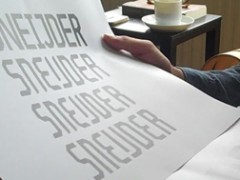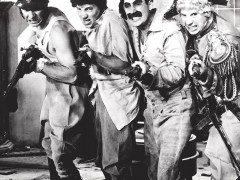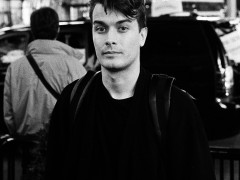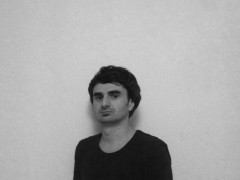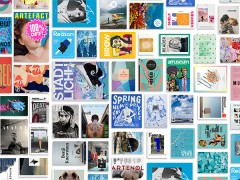An interview with Sam Winston, a typographic artist unlike any other
An exploration of semantics or an effective re-structuring of typography and words, whatever the case, Sam Winston's work is breathtaking.
A visual explorer of language, the London-based artist and educator has spent his working life examining the way we approach all kinds of literary artifacts.
Always engaging his audience with words in a stunning manner visually, Winston started writing stories and selling art books through London’s Institute of Contemporary Arts and can now be found in many special collections in the UK and the US, including – MoMA New York, Getty Research Institute, Los Angeles, the Tate Galleries London, and Victoria & Albert Museum.
This is the story of an artist who creates sculpture, drawings and books that question our understanding of words both as carriers of messages, and as information itself in his own 1.406 words or so.
Typeroom: Do you think dyslexia has defined your character and your skills?
Sam Winston: In brief, yes. Dyslexia has had a defining role in my practice but it would be misleading to say that it’s been seminal as to how I work. I think that – from a design perspective – a good solution has to first come from a problem – so any problem is a good departure point (even dyslexia) to produce something interesting. Which is also lucky as there are many problems in the world! From the artists’ perspective, I think it takes the broadest possible view, in that it looks at the problem of the human condition and explores that.

TR: How do you approach the creating procedure?
SW: Basically, this might sound very simple – but it’s thinking, looking and listening. These all happen in different orders depending on the environment I am in. My thinking is usually expressed in poetry, short stories and typography. The looking is explored through drawing, mark making and craft lead processes. And the listening? – Hard to say in words but generally meditative and induced by either wilderness or solitary environments. And I guess my job is to know when to do which.
TR: What is more important? The idea, the material, the form or the technique? Please put them in hierarchy.
SW: I rely on the idea of balance in work so usually I am always in a state of disharmony and ‘work’ is playing with balancing of that out. For example drawing is only useful once its framed in a broader conceptual framework. Or a conceptual artwork will only work once it has found the right embodiment – which could be through something like sculpture or performance.
TR: Which is your favorite piece of work and why?
SW: I prefer to view my work as a practice and a project is like full stops on that journey. So to stretch that metaphor – it’s the parts between the full stops that are interesting – yet almost impossible to exhibit. I guess – Orphan, Romeo and Juliet, Backwords, Drawing breath –all allude to that – a process that is saying something but never reaching a conclusion. I would hope the most useful thing one can get from looking at them is the impetus to engage your own creativity.
TR: Who is your favorite artist/poet/novelist/politician?
SW: Italo Calvino, Primo Levi, Kenny Goldsmith, Vieira da Silva, Tom Friedman, Aung Sung Suchi, Chongyam Trunkpa, Dom Sylvester Houedard, Maurice Sendak and Bernie Glassman.
TR: Have you developed a new understanding of text through your art?
SW: One of my favorite – and often repeated phrases is – more than half of language is silence. Be it spoken word or printed text – it has to be framed within space– and that space lets meaning exist. So if anything has developed through my art it is a deep appreciation of this generousness of space that we all have been given. Once that’s in place it is quite easy to let things appear on the page / or in the world.

TR: Do you find it hard to distinguish yourself frοm your work?
SW: The idea of owning the work – when I say that I am referring to learning from what is happening when I am making the piece. I would say I really own a project or artwork when it has taught me something I didn’t know. And then that will feed my sense of value. Intrinsically I feel learning is the only type of ownership we can have – I am not really talking about the literal ownership of objects. As for do I find it hard to distinguish myself from the work ? When I am in the flow or process of making it – there is no separation between self and work – it’s literally one. Once that stops – well it’s a cultural object – and is that me ? – not in a tradional definition of a ‘me’ its not.
TR: What is your most favorite text and why? Please quote it for us and explain why you favor it
SW: I love a text by James Baldwin called ‘the creative process’ - this is not the whole of it but to quote a little – “A society must assume that it is stable, but the artist must know, and he must let us know, that there is nothing stable under heaven.” It’s fierce and alive and I often love that energy of Wake Up – were not here long so live fully. The most I can find of it online is here.

TR: What is your favorite song at the moment?
SW: I found a 10 hour loop of the Skype ringtone on YouTube recently – it’s not a favorite song but that’s the last thing I remember actively looking to listening to part of. Beyond that – the soundtrack I follow is mainly whatever is going on in the immediate soundscape – right now that’s a police car in Hackney (London) and a cement mixer. Sorry to be so obtuse but I think we miss a lot when we only specify certain things to be listened to or watched – it limits the scope of what can be heard and seen.
TR: Which is your least favorite piece of art and why?
SW: I stopped taking sides a long time ago. For inspiration I go anywhere but the man made endeavor.
TR: What is your mantra?
SW: Why not.

TR: Which book touched you the most and what is the story behind it.
SW: There are some books that simply transcend the format of a book – Primo Levi – if this is a man – less about literature and more about bearing witness - yes it’s about a holocaust – but scarily, and profoundly its about humanity and what that means.
TR: You love folk tales, name your favorite.
SW: Oscar Wilde obviously was a great author of many new tales – and Marina Warner as a commentator on them.
TR: Which creature would you be in which fairy tale and in what ways do you identify with the mythical creature of your choice?
SW: Wood pigeon – they never make it into a story, totally irrelevant and if they do often end up in pies.
TR: Which is your most precious verse from what poem?
SW: Out beyond ideas of wrongdoing
and right-doing there is a field.
I’ll meet you there.
When the soul lies down in that grass
the world is too full to talk about.
Rumi.
TR: Kindly name one calligrapher and/or typographer whose work you believe should be introduced to the Typeroom crowd.
SW: Marion Deuchars is brilliant.
TR: What are your future plans?
SW: Myself and Oliver Jeffers are collaborating on a new children’s book and it should be out next year.
TR: What advice would you give to aspiring creatives out there?
SW: Consumption in our culture far outweighs the creation of it – so… don’t read about it - write about it. Don’t buy it – make it. And try and avoid getting others stuck in the trap of consumption. Always stay on the side of inspiration and creation – both in yourself and others. A sense of humor is a must!
TR: What do you think is the best way to close this interview and say goodbye?
SW: [ a space followed by a full stop] .
Tags/ typography, faces, artist, letterpress, sam winston, abstract typography, visual poetry



